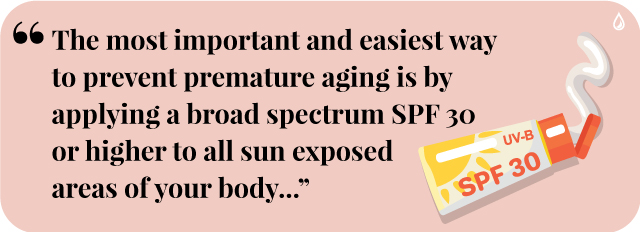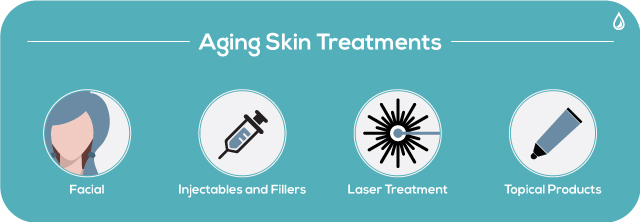
Scanning the headlines can be confusing when it comes to choosing products and procedures to slow and reverse the signs of aging. There’s so much information out there that you might find yourself asking: Where do I even start? What products are safe? Which treatments are right for me?
These are all valid questions. The good news is you’ve come to the right place.
The first step is to begin by assessing your main concern. It may be hyperpigmentation dark spots, fine lines and wrinkles, or redness and thinning of the skin. Perhaps you’re simply interested in finding the right daily skincare regimen. Whatever your priority, the right way to start treatment is to identify your main concerns, consult with your dermatologist, and create a plan.
To learn more, we spoke with Ryan Leach, board-certified Physician Assistant at The Dermatology Specialists, who provided a deep dive into the many safe and effective ways to prevent and slow the signs of aging — or even turn back the clock — so that your age can continue to be only a number.

There’s a lot you can do to prevent or slow down the signs of skin aging, and it’s never too late to start.
Simple steps include protecting yourself from the sun, using self tanner instead of laying out, gently cleansing your face, using moisturizer and washing your face after sweating. Diet and exercise play a role as well, so try to consume foods for healthy skin and stay active to boost your immune system.
“The most important and easiest way to prevent premature aging is by applying a broad spectrum SPF 30 or higher to all sun exposed areas of your body in the morning and again about every 90 minutes throughout the day,” says Ryan Leach.
“We also recommend patients stop smoking, avoid being exposed to secondhand smoke and eliminate tanning beds from their routine.”

The best treatment will depend on your specific concerns. The most common anti-aging treatments fall into a few main buckets: facials, injectables and fillers, laser treatments, and different topical products.
Facials: Currently, two of the best facials for anti-aging are platelet rich plasma (PRP) therapy and microneedling. In a microneedling facial, tiny needles penetrate the skin to boost collagen production. The process can be paired with PRP therapy using your own blood — hence its nickname, the “vampire facial.”
Chemical peels and microdermabrasion are two other anti-aging procedures which are frequently used on the face, neck, arms and back. During a chemical peel, topical agents (like salicylic or glycolic acid) are applied to the skin and then washed off to remove dead skin cells, which helps to diminish lines and wrinkles. Microdermabrasion uses a mechanical device to similarly exfoliate dead skin cells, improving skin cell turnover that leaves the skin looking replenished and smoother.
Injectables and Fillers: A wide variety of wrinkle treatments are used for different concerns — injectables such as Botox or Dysport are excellent options for fine lines and wrinkles, while other fillers are great for mitigating deep creases or facial volume loss. They are all minimally invasive and have different uses, costs and recovery times.
Laser Treatments: Among today’s most popular anti-aging options, lasers treatments are resurfacing procedures that penetrate deep within the skin to reduce fine lines and fade spots. New studies show laser resurfacing with a carbon dioxide laser reduces the appearance of wrinkles by 45% more than two years after treatment.
Photofacials (IPL) are another popular option to reduce the signs of skin aging. The 30-minute procedure uses pulses of light to penetrate deep into the skin to tighten and smooth fine lines.
Topical Products: When it comes to moisturizers, using them daily and making sure they have a couple key ingredients can maximize their effectiveness.
“The best moisturizers are those that contain hyaluronic acid, which works by pulling water into the skin and those that contain ceramides that help to form a healthy skin barrier and maintain moisture,” explains Ryan Leach.
In general, medical grade anti-aging products that are distributed only through dermatology or plastic surgery offices are going to be more effective than run-of-the-mill products you might order online or find in the store.
PRO TIP: Remember to apply your moisturizers after using products with active ingredients such as tretinoin!
Signs of aging can present differently in different skin types, so you should always speak to your dermatologist about a tailored approach to your skin.
That said, your basic skincare routine will generally evolve and change over the decades — using a heavier moisturizer, for example, or introducing the use of a prescription retinoid cream as you focus more on nighttime repair. Of course, sunscreen always remains a top priority since as much as 90 percent of aging can come from exposure to UV rays.
As certain skin aging signs become more noticeable, such as facial volume loss or deeper wrinkles, you may want to consider treatments like Botox or filler injections. Aging skin may also become thinner and less durable, so some topical products might need to be swapped out for gentler ones.
Though there may not be a fountain of youth to radically alter your age, there are many steps you can take to slow and reverse the signs of aging. Talk with your dermatologist to determine which procedures might work best for your age, concerns and skin type. With a few common sense steps and carefully chosen products, you’ll soon be on pace for brighter, healthier looking skin.
If you’re ready to take the next step, make an appointment today. We look forward to seeing you!
 Ryan Leach is a Physician Assistant at The Dermatology Specialists with an interest in acne, skin cancer screenings, minor surgical procedures, men’s health, and LGBTQ health. Ryan completed his undergraduate degree in Biobehavioral Health at the Pennsylvania State University and his Masters degree in Physician Assistant Studies from Chatham University. He is a member of the Society of Dermatology Physician Assistants and the American Academy of Physician Assistants.
Ryan Leach is a Physician Assistant at The Dermatology Specialists with an interest in acne, skin cancer screenings, minor surgical procedures, men’s health, and LGBTQ health. Ryan completed his undergraduate degree in Biobehavioral Health at the Pennsylvania State University and his Masters degree in Physician Assistant Studies from Chatham University. He is a member of the Society of Dermatology Physician Assistants and the American Academy of Physician Assistants.